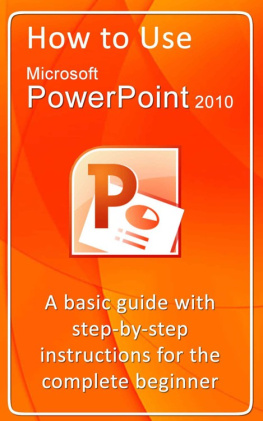HOW POWERPOINT MAKES YOU STUPID
Also by Franck Frommer
Jean-Patrick Manchette: Le rcit dun engagement manqu
HOW POWERPOINT
MAKES YOU STUPID
The Faulty Causality, Sloppy Logic,
Decontextualized Data,
and Seductive Showmanship
That Have Taken Over Our Thinking
FRANCK FROMMER
Translated from the French by George Holoch

The New Press gratefully acknowledges the Florence Gould Foundation for supporting the publication of this book.
English translation 2012 by The New Press
All rights reserved.
No part of this book may be reproduced, in any form, without written permission from the publisher.
Requests for permission to reproduce selections from this book should be mailed to:
Permissions Department, The New Press, 38 Greene Street, New York, NY 10013.
First published as La pense PowerPoint: Enqute sur ce logiciel qui rend stupide by La Dcouverte, Paris, 2010
Published in the United States by The New Press, New York, 2012
Distributed by Perseus Distribution
LIBRARY OF CONGRESS CATALOGING-IN-PUBLICATION DATA
Frommer, Franck.
[Pense Powerpoint. English]
How PowerPoint makes you stupid : the faulty causality, sloppy logic, decontextualized data, and seductive showmanship that have taken over our thinking / Franck Frommer ; translated from the French by George Holoch.
p. cm.
Includes bibliographical references and index.
ISBN 978-1-59558-702-2 (hardback)
1. Microsoft PowerPoint (Computer file)--Social aspects. I. Title.
HM851.F7813 2012
005.58--dc23
2011033975
The New Press was established in 1990 as a not-for-profit alternative to the large, commercial publishing houses currently dominating the book publishing industry. The New Press operates in the public interest rather than for private gain, and is committed to publishing, in innovative ways, works of educational, cultural, and community value that are often deemed insufficiently profitable.
www.thenewpress.com
Composition by the Influx House
This book was set in Janson Text
10 9 8 7 6 5 4 3 2 1
CONTENTS
I would like to give my warm thanks to all the men and women, experts or novices, creative or pragmatic, regular or occasional users, amateurs or professionals from very different sectors, who have accompanied me throughout this study. Without their thoughts and observations, my understanding of this powerful medium would not have been possible. They were enthusiastic in thinking about a tool of which they made constantand almost mechanicaluse in their daily life. It is refreshing to remark how many of these exchanges stimulated debates, brain waves, and fruitful hypotheses. PowerPoint leaves no one indifferent. For the sake of convenience and to avoid any embarrassment or unequal treatment, no last names are given and first names have been changed. Everyone quoted will recognize him-or herself. I would again like to thank all of them for their generous insights.
I would finally like to particularly thank Hugues Jallon, who encouraged me to carry out this study and provided invaluable help throughout its writing, as well as Vronique F., an intransigent reader who bore with great patience the slow maturation of this work, and Jeanne for her linguistic assistance.
In 2001, Microsoft estimated that 30 million PowerPoint presentations were given every day. The company now estimates that 500 million people use the program. The 2007 edition of Microsoft Office Home and Student, which includes PowerPoint, has been the best-selling software in the United States consumer market since 2008.... In France, sales have doubled in the last 18 months, according to a triumphant Microsoft press release at the end of 2009 announcing the coming launch of the 2010 version of the program.
Over the last ten years, PowerPoint, the computer-assisted presentation program by Microsoft, has become the indispensable medium for any oral presentation, from small office meetings to university lecture halls and major ad campaigns. Seldom has a commercial device exercised such dominance on the principal forms of collective communication represented by oral presentations and meetings. Even such sacred places as courtrooms and churches are now theaters of slide projections: it is possible to re-create a crime scene in court, and any preacher can rely on PowerPoint to enliven his sermons.
In the beginning, there was an ingenious program created in the 1980s by the first of the West Coast geeks. This precursor made it possible to produce organized, easy-to-use multimedia presentations simply and quickly. They could include animation, illustrations, photographs, sound, video, and hypertext links. It was already a complete and universal tool to create dynamic and snappy presentations, as the official site for PowerPoint still asserts.
At first, PowerPoint was intended primarily for office meetings or for the presentation of products and services. As it improved over time, the program acquired graphic and multimedia capabilities that opened the door to new territories: technological innovation made it possible with a few clicks and bullet points to adapt and simplify centuries of rhetorical art.
A tool for demonstrations, used for commercial or professional communication purposes, PowerPoint has invented a comprehensive rhetorical apparatus in which all the classic techniques of argument have been cleverly absorbed or transformed. It offers a particular form of expression for speech and proposes a kind of exhibition that has profoundly changed interpersonal relationships.
HOW A COMPUTER PROGRAM EDITS OUR THOUGHTS
PowerPoint makes us stupid. This is what Marine General James N. Mattis declared at a military conference (in a speech given without PowerPoint) in North Carolina in April 2010. The article in the New York Times reporting the remark revealed the pervasive role the software was playing in the American armed forces. It reached the point that the then head of American and NATO forces in Afghanistan, General Stanley A. McChrystal, accused PowerPoint of having become the U. S. Armys principal enemy, nothing less.
PowerPoint experienced phenomenal success as soon as it was released in 1987, but criticisms did not appear until the early 2000s. A first investigation, as serious as it was sarcastic, Can a Software Package Edit Our Thoughts? was published in the New Yorker in 2001. In it, Ian Parker relates, with many anecdotes, the meteoric rise of PowerPoint and already notes its ubiquity in places like schools and the military. He recounts that some bosses have already prohibited the use of PowerPoint in their companies. Ian Parker was one of the first to draw attention to the PowerPoint world:










